Educational Technology Solutions go beyond just internet-connected devices. They form a comprehensive system where tools and services, such as edge computing, cloud platforms, networking, and data centers, collaborate to make learning more accessible, engaging, and personalized. So how do these technologies work together in practice? Let’s explore more in the following article.
1. An Overview of Educational Technology Solutions
Educational technology refers to the use of digital tools, platforms, and methodologies to enhance teaching and learning experiences. It integrates hardware, software, and teaching strategies to create engaging learning environments that support students with different learning needs.
EdTech has been widely used in education for many years – from classroom devices like projectors and interactive whiteboards, to online learning apps and platforms such as Coursera, Duolingo, and FLYER. In the future, EdTech is expected to offer even more intelligent and convenient features to meet increasingly personalized learning needs.
2. Educational Technology Objectives
The growth of technology has always aimed to solve daily problems – and educational technology is no exception. EdTech solutions are designed to address key issues in education, such as personalized learning and equal access to knowledge. As a result, educators and learners gain the necessary foundation to grow and succeed in the digital age.
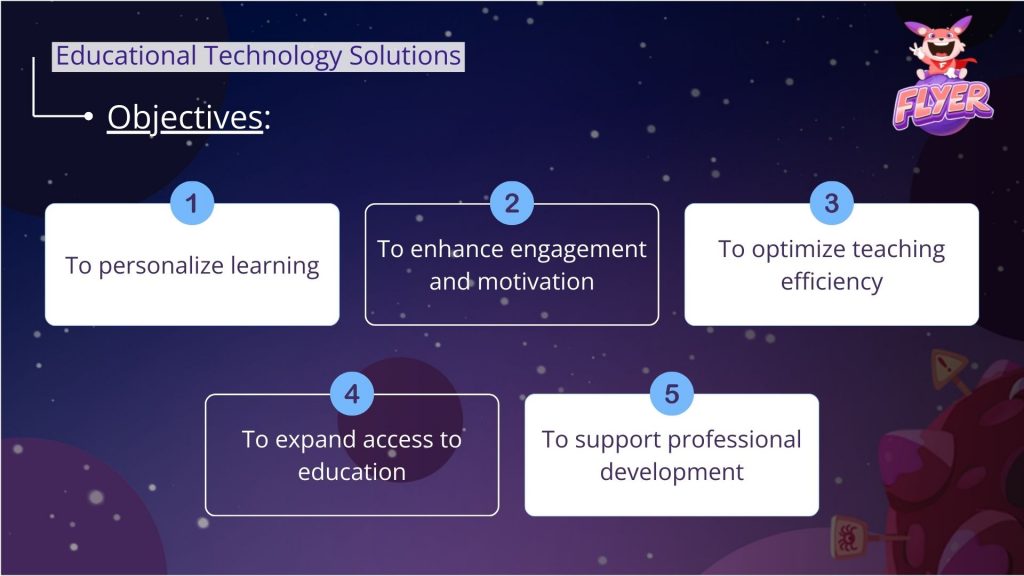
Some of the key objectives of EdTech include:
- To personalize learning: Using technology to tailor content and teaching methods to fit each student’s individual needs and learning pace.
- To enhance engagement and motivation: Applying elements such as gamification and interactive tools to make learning more enjoyable and stimulating.
- To optimize teaching efficiency: Reducing administrative tasks for teachers so they can focus more on instruction and student support.
- To expand access to education: Offering learning opportunities to students in remote areas or those facing challenges through online and distance learning platforms.
- To support professional development: Providing online training courses and resources to help teachers improve skills and teaching methods.
3. Key Benefits of EdTech Solutions
While objectives often focus on long-term goals, benefits are the positive outcomes that can be seen more quickly after implementing EdTech. An effective EdTech solution can bring the following key benefits:
- Improved learning outcomes: Students gain access to diverse and appropriate learning materials, which enhances academic performance.
- Cost savings: Digital resources reduce the need for printed materials, lowering expenses. For example, FLYER provides 1000++ online English tests aligned with Cambridge and ETS Qualifications. This helps both students and teachers cut down on traditional workbook and printing costs while maintaining access to engaging, interactive content.
- Greater interaction and collaboration: Online tools make it easier for students and teachers to communicate and collaborate during the learning process.
- Streamlined administrative tasks: EdTech automates tasks such as grading and attendance, reducing teachers’ workload.
- Faster feedback and assessment: EdTech enables real-time tracking and instant feedback, helping teachers quickly identify learning gaps, adjust instruction, and give timely feedback. For example, FLYER SCHOOL offers a comprehensive dashboard for teachers and school leaders. It provides automatic scoring, progress tracking, and detailed performance reports for each student.
- Data-driven decision making: Analytics tools help identify learning gaps and adjust teaching strategies more effectively.
- Lifelong learning: Online platforms promote continuous education, enabling learners to upgrade their skills and knowledge throughout their careers.
4. EdTech Challenges and their Solutions
While there are many advantages to using EdTech solutions, teachers and school leaders may also face several challenges when implementing EdTech solutions. However, these challenges can be addressed with the right strategies.
Here are some common challenges in integrating EdTech, and the solutions to help overcome them:
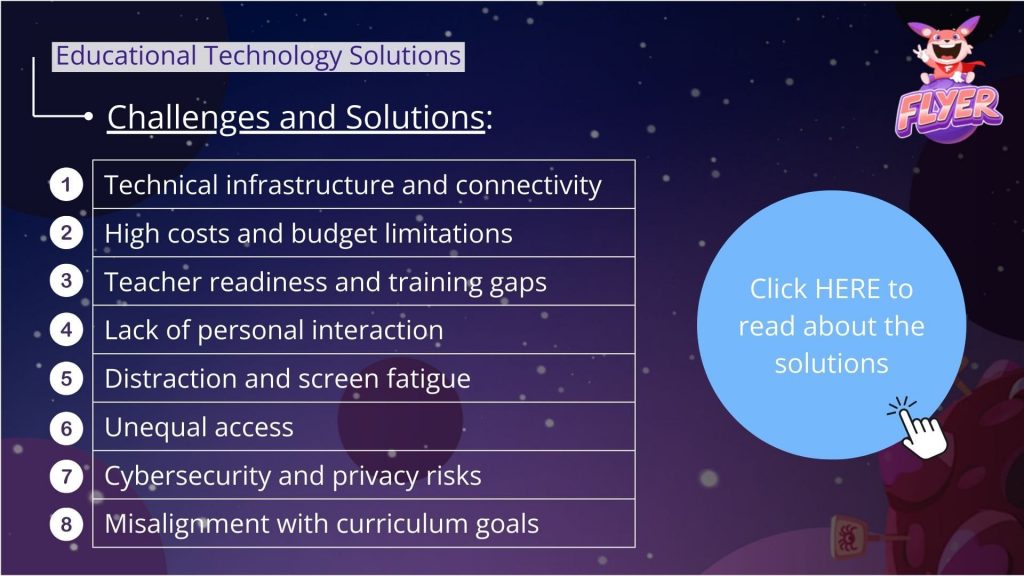
| Challenges | Solutions |
|---|---|
| Technical infrastructure and connectivity: Many schools still lack reliable internet access, modern devices, or stable IT infrastructure. → This leads to an inconsistent learning experience and limits the potential of EdTech tools. | Invest in flexible infrastructure, prioritize hybrid/ offline tools in low-connectivity areas, and collaborate with public or private partners for funding and support. |
| High costs and budget limitations: The cost of devices, software licenses, and maintenance is a barrier, especially for public schools or rural institutions. | Select open-source or low-cost educational platforms, and consider shared-device models. |
| Teacher readiness and training gaps: Teachers may feel overwhelmed or unprepared when using new technologies, especially without proper support or training. | Provide ongoing professional development, create peer mentoring systems, and offer practical training that aligns with real classroom needs. |
| Lack of personal interaction: Over-reliance on EdTech may reduce real-life interaction between students and teachers, weakening emotional and social development. | Use technology to complement, not replace, human teaching. Encourage blended learning approaches that balance screen time with face-to-face interaction. |
| Distraction and screen fatigue: Learners, especially younger ones, can be easily distracted by devices or experience fatigue from long hours in front of screens. | Incorporate short, engaging activities and screen breaks. Design lesson plans that include offline tasks to keep students focused and energized. |
| Unequal access: EdTech can unintentionally widen the gap between students who have access to devices and the internet and those who don’t. | Provide community-based learning centers with internet access, and ensure content is mobile-friendly and accessible offline where possible. |
| Cybersecurity and privacy risks: As EdTech tools gather user data, schools must ensure they comply with privacy laws and protect student information. | Select platforms with strong privacy policies, educate teachers and students on digital safety, and enforce clear data governance policies. |
| Misalignment with curriculum goals: Technology may be exciting, but not all tools align with learning outcomes or curriculum standards. | Involve educators in tool selection, evaluate platforms based on curriculum relevance, and ensure digital content supports learning objectives. |
5. Emerging Technologies in Education in 2025
The explosion of technology has started a new era for education, bringing a wide range of EdTech solutions that are not only smarter and more efficient but also help educators significantly reduce operational costs. Below are some standout emerging EdTech tools that teachers and school leaders can explore and apply in classrooms.
5.1. AI-Powered Teaching Assistants
Artificial Intelligence (AI) is transforming classrooms by automating administrative tasks such as grading, lesson planning, and student performance analysis. One example of AI in education is FLYER’s AI Bingo feature.
With FLYER Bingo AI, learners can engage in conversations with the virtual assistant “Bingo” to practice speaking skills anytime. Bingo not only interacts with learners in a human-like way but also provides detailed feedback to help them improve quickly.
In 2025, AI continues to show significant development, especially with the rise of personalized learning. Adaptive learning platforms now use machine learning and natural language processing (NLP) to assess student performance, customize lessons to meet individual needs and improve their outcomes. Moreover, voice-activated technologies are improving accessibility, creating hands-free and more inclusive learning environments.
5.2. Immersive Learning with AR, VR and MR Technologies
By simulating real-world environments and physical states, Augmented Reality (AR) and Virtual Reality (VR) technologies create engaging learning experiences for both teachers and learners.
One example is that students can explore historical landmarks or conduct virtual science experiments right in their classrooms, making the experience as vivid and exciting as a real-life trip.
In addition, Mixed Reality (MR), which blends elements of both AR and VR, offers even more dynamic educational opportunities. It enables students to interact with 3D holograms and digital content integrated into their physical surroundings.
For example, in medical education, students can examine detailed 3D models of human anatomy; or in history classes, MR can transport students to significant historical events, providing a deeper connection to the past.
5.3. Microlearning and Bite-sized Learning
Microlearning delivers short, focused lessons (2 – 10 minutes) that target specific skills or concepts. It suits busy learners and supports quick knowledge retention.
An example of Microlearning is the Cambridge-standard mini tests offered on FLYER, which last only 5–10 minutes. These tests are specifically designed for children, who enjoy learning through play and often have a limited attention span. With short and engaging exercises, they offer a great way for children to practice English in an enjoyable yet highly effective manner.
On the other hand, bite-sized learning divides complex content into smaller, more manageable parts, making it easier for learners to grasp challenging topics. Unlike microlearning, it is usually integrated into a larger course framework. This method helps reduce cognitive overload and improves learning flow.
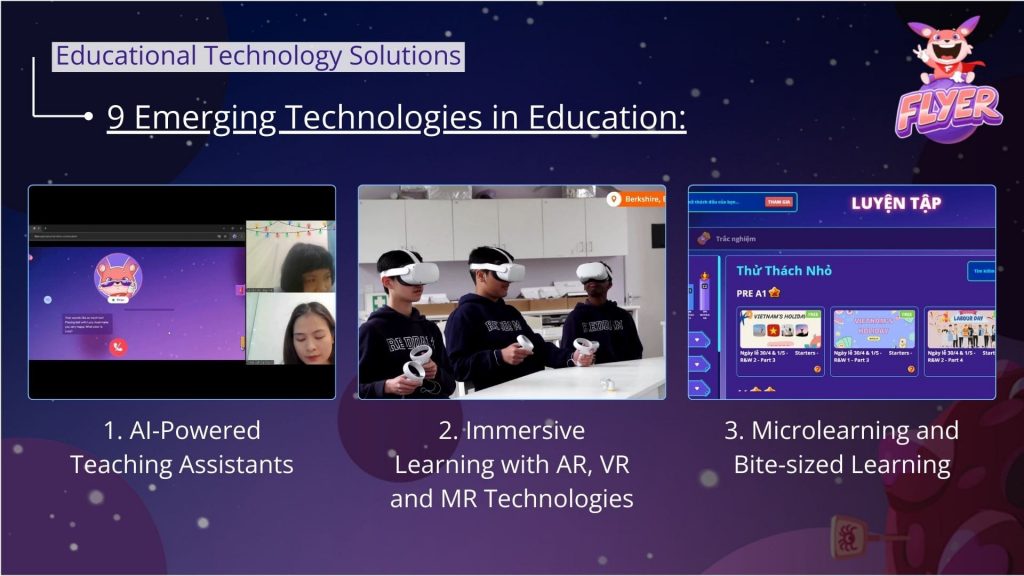
5.4. Gamification in Education
Using elements such as points, badges, and leaderboards, gamification brings the fun and motivation of games into the classroom. This approach can turn even the most routine lessons into exciting challenges, encouraging students to stay engaged and motivated.
Tools such as FLYER allow teachers to create dynamic learning environments where students are rewarded and ranked after completing challenges, and can compete with friends to encourage healthy competition.
By making learning more interactive and enjoyable, gamification helps foster a deeper connection to the subject matter.
5.5. Cloud-Based Collaboration Tools
Cloud technology enables students and teachers to access learning materials anytime, anywhere. Platforms such as Google Classroom and Microsoft Teams facilitate real-time collaboration and communication, supporting flexible and remote learning environments.
5.6. Inclusive Education with AI
Inclusive education is evolving thanks to AI tools that help accommodate students with different learning challenges. Real-time translation and personalized learning resources enable learners with language barriers or special educational needs to access content more effectively.
Moreover, features such as text-to-speech, closed captions, and adaptive user interfaces are becoming standard, allowing every learner to engage meaningfully with the content.
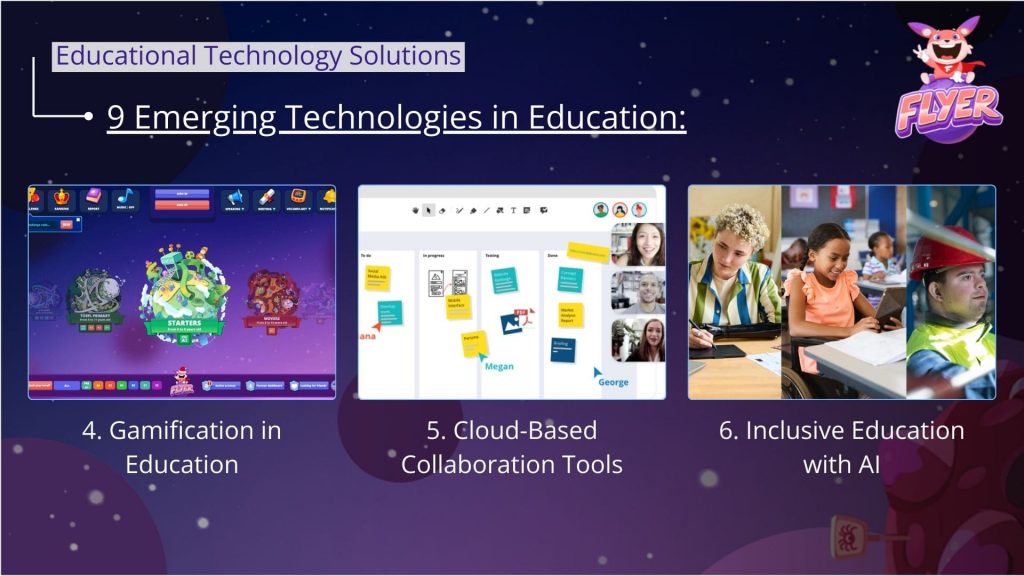
5.7. Internet of Things (IoT) in Smart Classrooms
IoT technologies create smart classrooms by enhancing interactivity and collecting real-time data. For example, devices such as smartboards and sensors can track student engagement, allowing teachers to adjust teaching methods and tailor learning experiences to individual needs. Similarly, wearable devices can monitor students’ attention levels and emotional states, supporting more responsive and personalized teaching.
Beyond student engagement, IoT tools also help optimize the physical learning environment. Sensors can monitor classroom conditions like temperature, air quality, and lighting, ensuring that students remain comfortable and focused throughout the school day.
5.8. Blockchain for Credentialing
By providing secure, verifiable credentials for teachers and learners, blockchain is transforming education and English teaching in general. Platforms such as Bridge TEFL/TESOL offer blockchain-based micro-credentials that certify specific teaching skills, enhancing trust and portability of qualifications. Similarly, BitDegree utilizes blockchain to issue NFT certificates for course completions, integrating gamified learning experiences with tangible rewards.
These blockchain solutions ensure that credentials are secure, easily shareable, and globally recognized, streamlining the verification process for employers and educational institutions.
5.9. 5G Connectivity
The rollout of 5G networks provides faster and more reliable internet connections for teaching and learning activities. This supports high-quality video streaming, real-time collaboration, and access to rich multimedia content.
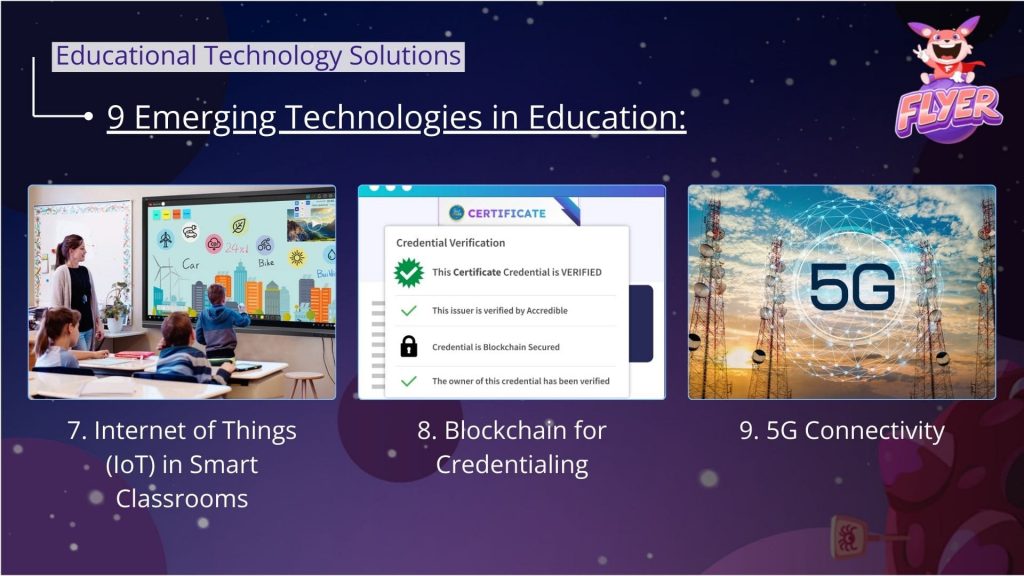
6. Success in Education: How Schools Benefit from EdTech Solutions
6.1. Geekie – Personalized Learning in Brazil
Geekie is an adaptive learning platform that uses machine learning and big data tools to help personalize education at large scale.
In Brazil, where only 20% of students complete high school, Geekie has developed a personalized digital learning platform that now reaches over 5 million students across 20,000 schools. By assessing individual learning gaps, Geekie tailors study plans to meet each student’s unique needs.
This approach has led to a 30% improvement in student performance within just two months. The platform is especially valuable in underserved areas, offering comprehensive lessons and exercises to address diverse learning needs.
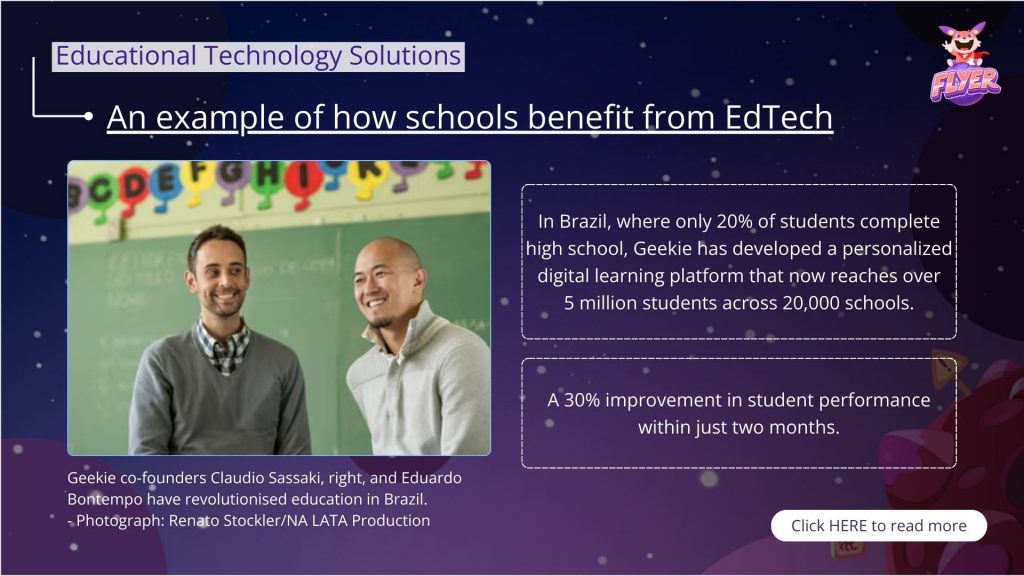
6.2. St Joseph’s School – Blended Learning Success
During the pandemic, St Joseph’s School in England embraced EdTech to offer a combination of live (synchronous) and recorded (asynchronous) lessons. Even after the lockdown ended, the school continued to use digital tools like Microsoft Teams and Google Forms to identify and address learning gaps.
This approach has been especially beneficial for students from low-income families, ensuring they have access to quality education and resources. By integrating technology, the school has fostered greater collaboration among teachers and improved student outcomes.
7. FAQs about Educational Technology Solutions
An EdTech solution is a tool or platform that uses technology to support and enhance teaching, learning, and educational management.
The aim of EdTech is to:
– Personalize learning
– Enhance engagement and motivation
– Optimize teaching efficiency
– Expand access to education
– Support professional development
EdTech refers to the broader use of technology in education, including tools for teaching, learning, and administration. eLearning is a specific aspect of EdTech focused on online learning and digital courses.
There are 6 EdTech trends expected to transform education in 2025:
– AI-powered personalized learning tailors content to individual students using machine learning and NLP (natural language processing).
– Immersive learning with XR (Extended Reality) enhances engagement through AR, VR, and MR (Mixed Reality) experiences.
– Microlearning delivers short, focused lessons for flexible, on-demand learning.
– Gamification of education boosts motivation through game-like elements such as points, badges, and leaderboards.
– Blockchain for credential verification secures and streamlines academic record sharing.
– Accessibility and inclusive design ensures learning tools support all learners, including those with disabilities.
Conclusion
To sum up, educational technology has become a vital part of classrooms over the years. Although challenges remain, the continuous evolution of EdTech platforms is making them increasingly effective in meeting the diverse needs of both teachers and students. Hope this article has offered valuable insights to support educators in the journey with educational technology.
Discover more



